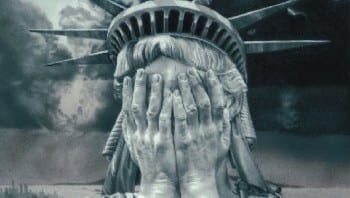THE DUOPOLY WATCH | Steven Jonas, MD, MPH![]()
Special to The Greanville Post | Commentary No. 69: “The Dominant Sector of the Ruling Class Takes Full Control, Part I: A Brief History of the Ruling Class in the U.S. ” Image above: Exxon’s chief Rex Tillerson meeting with Clintonites’ nemesis, Pres. Vladimir Putin. Tillerson is reputedly the most likely candidate to occupy the State Department slot.
Vladimir Ilyich Lenin, the great theoretician and leader-in-practice of socialist revolution, said, concerning the nature of “constitutional democracy” under capitalism, put it this way:
“To decide once every few years which member of the ruling class is to repress and crush the people through parliament – this is the real essence of bourgeois parliamentarism, not only in parliamentary-constitutional monarchies, but also in the most democratic republics.”
The ruling class of the United States has had two or three sectors controlling the political economy of the nation, ever since the Founding. Up until the Civil War, once mercantile capitalism established itself in the North there were two: the Slavocracy in the South, represented in the national government by the Democrats, (who were anything but democratic), and the burgeoning mercantile- then industrial class in the North (represented by the Whigs).

Tillerson conferring with Putin at the Kremlin. Criminal and duplicitous as Exxon has been in connection with the environment, it is undeniable that for his own reasons, Tillerson might actually defuse the drive to war with Russia, and thereby give a break to the planet, which a nuclear war would certainly finish off even quicker than climate destabilization. This is a political space that activists should employ wisely and promptly. The cold fact is that a Democrat administration, demagogy aside, and silly arguments from liberals notwithstanding (as Obama’s treachery so amply proved), would not have done more than Trump for the environment, which is just about zero. The inevitability of real struggle has been there all along.
[dropcap]A[/dropcap]fter the Civil War, the Northern capitalist class, operating the rapidly expanding industrial economy, came to be controlling. The Whigs, with a few bits and pieces including the Temperance movement and the xenophobes of the “American Party” (both of which have remained in the GOP’s elemental fabric down to the present day) morphed into the Republican Party. Although the latter had of course led the anti-Slavocracy North in the Civil War, it quickly morphed, after 1876, into the party of burgeoning capital. At the same time, it very conveniently allowed the successor to the Slavocracy — that is the Slavocracy in everything but the physical ownership of other human beings — to stay in place in the South.
In the late 19th century a third ruling class branch appeared, bent on reform of the worst excesses of rapidly expanding capitalism and its relations of production. The leadership was provided by such men as William Jennings Bryan, Theodore Roosevelt, and Woodrow Wilson, and certain limited reforms were achieved under the Presidencies of the latter two. It should be noted that even the very mild forms of socialism-under-capitalism, tolerated by their capitalist ruling classes as a way to maintain power without facing the risk of revolution, that appeared in certain countries in Western Europe, was never on the agenda of any the ruling class sectors in the United States.
The control of the dominant U.S. industrial ruling class sector outside of the South was re-established in the 1920 elections. The appearance of the New Deal in 1933, in order to attempt to deal with some of the worst excesses, and indeed tragedies, of the Great Depression, was brought about by the re-emergence of the third-track reformist element of the ruling class. Indeed, many observers at the time and since have regarded Franklin Roosevelt’s primary task, in which, with the help of the Second World War which made the United States one of the two dominant world powers, he succeeded admirably, was to preserve U.S. capitalism and it ruling class, without so much as a whiff of European socialist democracy.
The reformist wing of the ruling class preserved much of the New Deal under Eisenhower and then put certain of the demands of the Civil Rights movement, as well as a modest reform of the health care financing system for certain elements of the population, into legislation under Kennedy/Johnson. Lyndon Baines Johnson planned a moderate expansion of the New Deal in his plan for a Great Society, but that, and he, as well as 2,000,000 Vietnamese and 57,000 U.S. servicemen fell into the swamp of the Big Muddy. It was during that period that the formerly dominant, industrial-based (now joined by the Petro-chemical sector), right-wing element of the ruling class began its resurgence, starting with the candidacy of Barry Goldwater. With fits and starts under Nixon, Reagan, Bush I and Bush II, they have been gradually reasserting that dominance.
With the emergence of the Democratic Party as the sponsor of civil rights legislation and what can be called the Second (Partial) Emancipation, the dominant sector’s political party, the Republicans of course, starting with Nixon’s “Southern Strategy” took over the successor to the Slavocracy ruling class sector. They proceeded to totally integrate (if I may use that term) its policies, its programs, and its propaganda into that of the Republicans. Indeed, they became the modern party of racism. They have been greatly helped by the takeover of the Democratic Party by its own right-wing, called the Democratic Leadership Council (DLC).
[dropcap]W[/dropcap]ith the emergence of the Democratic Party as the sponsor of civil rights legislation and what can be called the Second (Partial) Emancipation, the dominant sector’s political party, the Republicans of course, starting with Nixon’s “Southern Strategy” took over the successor to the Slavocracy ruling class sector. They proceeded to totally integrate (if I may use that term) its policies, its programs, and its propaganda into that of the Republicans. Indeed, they became the modern party of racism. They have been greatly helped by the takeover of the Democratic Party by its own right-wing, called the Democratic Leadership Council (DLC). Bill Clinton’s “achievements” highlight the role and function of this part of the Duopoly that has, since the collapse of the Great Society program, run the country. Barack Obama represented the modern version of the DLC, sort of fuzzying it up and moving forward on certain issues of personal liberty like gay rights, minor labor reform, and minor health care financing reform.
Of course, the expectation of most observers, including this one, was that this election would be won by the “other Clinton.” But because of both the interference of the FBI Director, and the fundamental weakness of her campaign, which was stuck with her DLC-past, in the Electoral College she lost. (There is a marvelous irony there. In major part the Electoral College was created at the Founding to preserve and protect the interests of the Slavocracy. It has now given us Trump and the re-emergence of the dominant, right-wing, sector of the ruling class [see below].) Clinton did not run a truly progressive (even in the capitalist-reformer sense) campaign. Since the third, reformist element, of the ruling class had been crushed by the very force within the Democratic Party that her husband and she helped to create, she lost states which on paper she should have won, in part at least due to the rampant racism (and xenophobia, mysogny, and Islamophobia) of the Trump Campaign, which she did little to combat, and well as her “DLCish-ness.”
And so, surprise! Trump wins. No one except perhaps his most die-hard supporters expected that. I certainly didn’t. But he did. And President he will be. Just what sort of President he will be is another matter. A real one, or a Twitter-hound who would really rather be doing something else — like making some real money now selling his name around the world? Since he has, for example, told us that he does not attend daily intelligence briefings and will not, because he “is very smart,” the indications are “something else.” (Many observers are observing on that one and I will too, somewhere down the road.) But whatever he does and however he conducts himself once in office, what he has done with his announced appointments is make it quite clear that finally, after many fits and starts over almost a century since the election of 1933, the fully-right wing/reform-forget-it, industrial/Petro-chemical/food-pharma-retailing/financier, ruling class sector is fully back in power. Ironically for the consciousness of most mainstream liberals, actually a shock if they realized it or if someone they trust told them, the GOP’s revival is directly the product of deliberate and typically duplicitous Democratic party policies under the Clinton/Obama regime. In 2008, even modest but real reforms implemented by Obama when the nation literally demanded change after the Bush2 debacle, was squandered via the continuation of Bush policies behind a different mask, while Obama and the DNC went out of their way to pick up the badly defeated Republicans up from the canvas.
Although there is enormous resistance to Trump—much of it as usual for the wrong reasons—and Trump is a minority President, he and the Dominionist Mike Pence are technically fully in control of the levers of government, through the Executive and Legislative branches, and soon enough the Supreme Court too. And it is those class interests, or, again, more precisely, those specific factions within the ruling class, which without any need to compromise, nor any need to genuflect even slightly in the direction of the traditional element of the Duopoly known as the Democratic Party, will be dominant for at least the next four years.
As I have said previously, BY HIS APPOINTMENTS THOU SHALT KNOW HIM. We will delve more into what they mean and why they are happening in the next column.
Senior Editor, Politics, Steven Jonas, MD, MPH is a Professor Emeritus of Preventive Medicine at Stony Brook University (NY) and author/co-author/editor/co-editor of over 30 books. In addition to being Senior Editor, Politics, for The Greanville Post, he is: a Contributor for American Politics to The Planetary Movement; a “Trusted Author” for Op-Ed News.com; a contributor to the “Writing for Godot” section of Reader Supported News; and a contributor to From The G-Man. He is the Editorial Director and a Contributing Author for TPJmagazine.us. Further, he is an occasional Contributor to TheHarderStuff newsletter, BuzzFlash Commentary, and Dandelion Salad. Dr. Jonas’ latest book is Ending the ‘Drug War’; Solving the Drug Problem: The Public Health Approach, Brewster, NY: Punto Press, available on Kindle from Amazon at http://www.amazon.com/Ending-Drug-War-Solving-Problem-ebook/dp/B01EO9RGKO/ref=sr_1_4?s=books&ie=UTF8&qid=1461783388&sr=1-4&keywords=Ending+the+Drug+War
His most recent book on US politics is The 15% Solution: How the Republican Religious Right Took Control of the U.S., 1981-2022: A Futuristic Novel (Trepper & Katz Impact Books, Punto Press Publishing, 2013, Brewster, NY), and available on Amazon.





To a layman it seems that the US has definitively reverted to its 1776 political pattern, with a small coterie in charge of extremely wealthy men with a huge control over large parts of the economy. The people count for rather little except in their mass support for whosoever lays a claim to lead their diffuse aspirations for independence and acquisitive needs. The myth of exceptionalism has returned the nation full circle to the beginnings of the Republic, an interesting backwards trend well predictable from the original fear of being overrun by the ancient colonial empires as if they had… Read more »